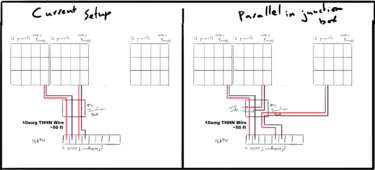Remember, everything outdoors that is metal must be grounded. This means panels, racks, conduits, boxes, etc. Anything outdoors that is not metallic, like ABS plastic boxes or PVC conduit, if having current carrying conductors passing through them must have the ground wire, insulated or bare passing through them from the origin point to the termination point of the ground connection. The DC circuits for the PV and inverter can be grounded at a grounding rod near the array or inverter and this can be done separately from the AC grounding if you are grid tied.
So, just to be clear, say you have a metallic combiner box with your PV ground connected at this box as well as a grounding rod at the array, then the PV output from the combiner box uses PVC conduit outdoors for the PV+ and PV-, then only those 2 wires need to go to the inverter, not the ground. IF those 2 wires enter a structure, then they must transition from PVC to metallic enclosure indoors such as metallic conduit or wire raceway. And the metallic conduit or wire raceway must be grounding like the inverter is grounded. The inverter still must be grounded, either using a grounding rod by the inverter or if grid tied using the grid supplied ground.




